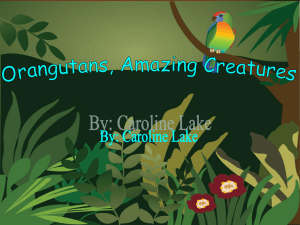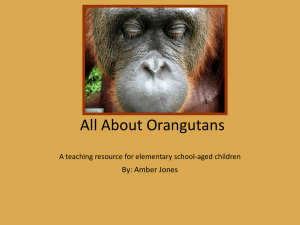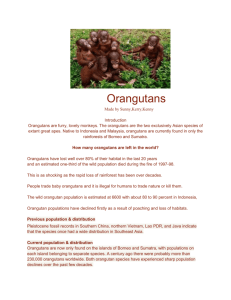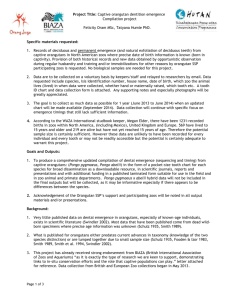Orangutans & Palm Oil Case Study Orangutans and
advertisement
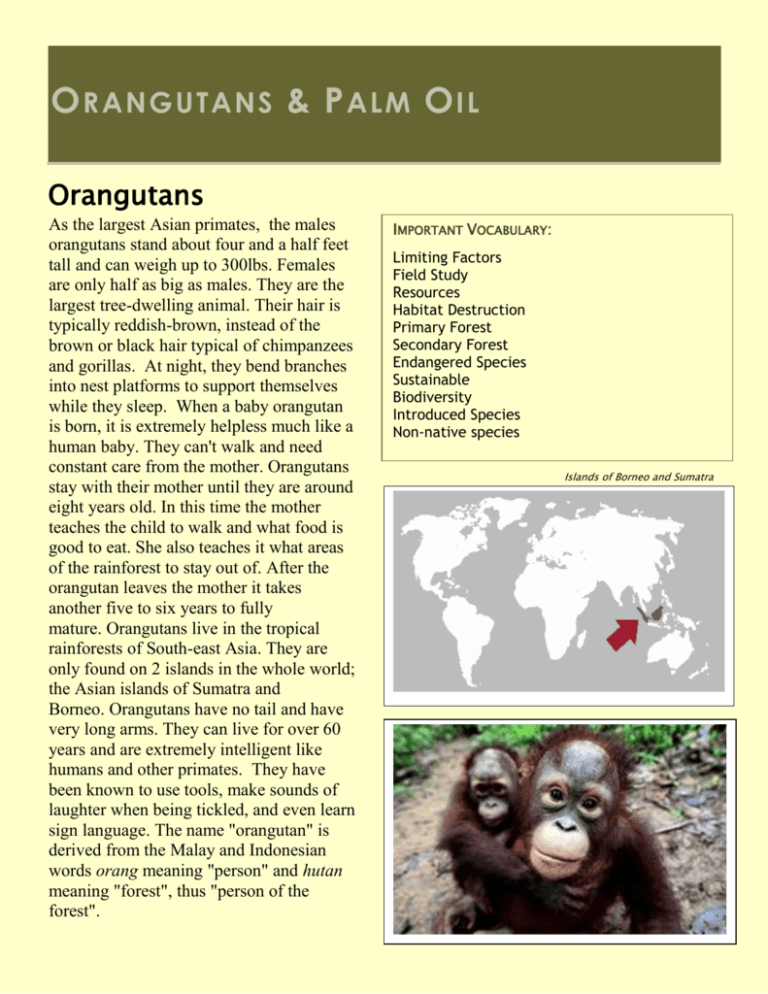
O RANGUTANS & P ALM O IL Orangutans As the largest Asian primates, the males orangutans stand about four and a half feet tall and can weigh up to 300lbs. Females are only half as big as males. They are the largest tree-dwelling animal. Their hair is typically reddish-brown, instead of the brown or black hair typical of chimpanzees and gorillas. At night, they bend branches into nest platforms to support themselves while they sleep. When a baby orangutan is born, it is extremely helpless much like a human baby. They can't walk and need constant care from the mother. Orangutans stay with their mother until they are around eight years old. In this time the mother teaches the child to walk and what food is good to eat. She also teaches it what areas of the rainforest to stay out of. After the orangutan leaves the mother it takes another five to six years to fully mature. Orangutans live in the tropical rainforests of South-east Asia. They are only found on 2 islands in the whole world; the Asian islands of Sumatra and Borneo. Orangutans have no tail and have very long arms. They can live for over 60 years and are extremely intelligent like humans and other primates. They have been known to use tools, make sounds of laughter when being tickled, and even learn sign language. The name "orangutan" is derived from the Malay and Indonesian words orang meaning "person" and hutan meaning "forest", thus "person of the forest". IMPORTANT VOCABULARY: Limiting Factors Field Study Resources Habitat Destruction Primary Forest Secondary Forest Endangered Species Sustainable Biodiversity Introduced Species Non-native species Islands of Borneo and Sumatra Page 2 Studying Orangutans Scientists work very hard to study orangutans. In order to get accurate information about orangutans, scientists must conduct what we call field studies. A field study is a term used to explain the scientific study of free-living wild animals in which the subjects are observed in their natural habitat, without changing, harming, or altering the setting or behavior of the animals. Field studies are much different than laboratory experiments because there are many things that you cannot control in a field study the way you could in a lab. This can involve countless hours and possibly years of work hiking through the rainforest counting and observing the orangutans. Because orangutans are endangered, it is important to try and get an accurate population count. Counting animals in the wild can be very difficult because they move and hide. Sometimes scientists use a mark and recapture technique where they go out and capture as many of the animals as possible and mark them somehow. Maybe they tag them and then let them go. That Newsletter Title Human Impact Because orangutans live in only a few places, and because they are so dependent upon trees, they are particularly susceptible to logging in these areas. Unfortunately, deforestation and other human activities, such as hunting, have placed the orangutan in danger of extinction. Therefore, Orangutans are considered to be an endangered species which means that there are not very many of them left in the world. If nothing is done to prevent their extinction, scientists estimate that they will be gone within the next 10 years. One of the main reasons is because their habitats and forests they live in are being destroyed so we can grow oil palm trees and put palm oil in our food. Oil palm trees are a great crop for humans because they grow fast and produce lots of fruit that can be turned into oil. If you read the labels of many common food items, you will see palm oil listed as an ingredient. Unfortunately, oil palm trees grow best in tropical environments like the islands of South-east Asia where the orangutans live. Ironically, oil palm trees way if they are recaptured the next time they go are not native to Asia. They are actually a species of out, they know not to count them. After repeating palm tree from Africa, but people have introduced the process multiple times throughout an area, the oil palm trees to Asia in order to make more and scientists can use a mathematical equation to more palm oil. Now palm oil plantations are taking estimate how many total there are in the over large areas where there used to be forest for population. Another method is to pick a specific the orangutans to live in. When an animal’s habitat measurable section of land, called a quadrant, and is destroyed in any way, it is called habitat count the animals found in that section and then destruction. Since their homes are being destroyed, multiply it by the total amount of land area. the orangutans are limited as to where they can live Calculating the population density is also and find food. This often puts them in competition important because it can tell you how many with humans for resources. In this case, limiting animals live in a specific area. When you know factors that are causing the population of these things about the population of an animal, orangutans to decline are lack of habitat, food, then you are better able to help it. If you know, for instance that a species is found mostly in only one area of the forest you might be able to protect that one area even if the rest is torn down for human use. shelter, and other resources due to human activity and competition for the same resources. Newsletter Title Page 3 What is being done? Scientists are working hard trying to find solutions to help the orangutans. One possible solution that could help the orangutans is to provide protected areas of the rainforest that cannot be cut down and used for growing palm oil. While protected areas usually help endangered species, this could be tricky as much of the forest has already been cut down and it takes time for the forest to regrow and often once it does regrow, it has changed in some ways. This process is known as succession and can be explained as the process plant life goes through as it takes over a region. Old forests that have been around for a long time are called primary forests and research has shown that orangutans prefer this type of forest. Once the forest has been burned or cut down and has regrown or is in the process of reestablishing plant life, it is called secondary forest and is less ideal for the orangutans. This has been a problem that scientists have been studying for some time. The good news is that there are now signs that the orangutans are adapting to live in the secondary forests and protecting them will help the orangutans. Another solution that is being researched is to make the production of palm oil more sustainable. Sustainable methods refer to a way of doing something without using up all of the natural resources so that you can continue to use these methods for a long time without causing further harm. For this reason, there are organizations out there helping to make the process of farming oil palms more sustainable. Often oil palm plantations are put right in the center of a large area of forest and therefore sustainable farming involves allowing a path through the palm oil plantations so that the orangutans can easily travel from one side to the other. And because the orangutans are passing through the plantations, it is important that the palm oil plantations be careful not to use any chemicals that could harm the orangutans. Research has shown that these sustainable methods can help save the orangutans, and oil palm farmers can now get certified if they use sustainable farming methods. However, it tends to be a little more expensive to use sustainable farming methods so not everyone is using the sustainable methods. In the end, it may come down to supply and demand. If people choose to buy only the products with sustainable palm oil, then the farmers will be more likely to use the sustainable methods that help the orangutans. Do you read the labels of your foods to know whether or not they contain palm oil and if the palm oil is farmed in a sustainable manner? Reading Comprehension Questions: 1. What does Orangutan mean? 2. Where are Orangutans found? 3. What is a field study? 4. How are field studies different from research done in a lab? 5. Why is understanding population size important when studying endangered species? 6. Why are orangutans extra susceptible to extinction? 7. List 2 things that threaten orangutans. 8. What is an unintended consequence of farming & using a lot if oil palms? 9. Why are oil palm trees considered an introduced species? 10. Name some limiting factors that are keeping the population of orangutans from growing. 11. What are 2 things that can be done to help the orangutans? 12. What are 2 main things that determine if palm oil is sustainable?
